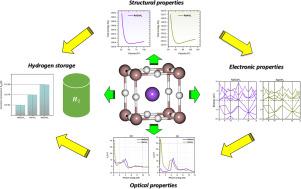Prediction of the structural, phonon, electronic, optical, and hydrogen storage properties of NaXH3 (X = Ga, In) hydride perovskites
IF 3.9
Q3 PHYSICS, CONDENSED MATTER
引用次数: 0
Abstract
In this manuscript, we have investigated the hydrogen storage, structural, optical, phonon, and electronic properties of the perovskite hydrides NaXH (X Ga, In) using first-principles calculations. The calculated formation energies ( for NaGaH and for NaInH) confirm that these compounds exhibit thermodynamic stability. Phonon dispersion analysis reveals that NaInH is dynamically stable, whereas NaGaH exhibits dynamical instability due to the presence of imaginary frequencies. Electronic band structure calculations indicate that both compounds display metallic behavior. Regarding their optical response, they show strong reflectivity in the visible region and significant absorption in the ultraviolet range. The hydrogen storage analysis yields gravimetric capacities of 2.15 wt% for NaInH and 3.16 wt% for NaGaH, with corresponding desorption temperatures of 515.76 K and 525.63 K, respectively. These results provide fundamental insights into Na-based hydride perovskites and highlight their potential as promising candidates for the next generation of hydrogen storage technologies.

NaXH3 (X = Ga, In)氢化物钙钛矿的结构、声子、电子、光学和储氢性能预测
在本文中,我们利用第一性原理计算研究了钙钛矿氢化物NaXH3 (X = Ga, In)的储氢、结构、光学、声子和电子性质。计算得到的形成能(NaGaH3为- 5.33eV, NaInH3为- 5.24eV)证实了这些化合物具有热力学稳定性。声子色散分析表明,NaInH3具有动态稳定性,而NaGaH3由于虚频率的存在而表现出动态不稳定性。电子能带结构计算表明,这两种化合物都表现出金属性质。在光学响应方面,它们在可见光区表现出很强的反射率,在紫外区表现出明显的吸收。储氢分析结果表明,NaInH3和NaGaH3的重量容量分别为2.15 wt%和3.16 wt%,相应的解吸温度分别为515.76 K和525.63 K。这些结果提供了对na基氢化物钙钛矿的基本见解,并突出了它们作为下一代储氢技术的有希望的候选者的潜力。
本文章由计算机程序翻译,如有差异,请以英文原文为准。
求助全文
约1分钟内获得全文
求助全文
来源期刊

Computational Condensed Matter
PHYSICS, CONDENSED MATTER-
CiteScore
3.70
自引率
9.50%
发文量
134
审稿时长
39 days
 求助内容:
求助内容: 应助结果提醒方式:
应助结果提醒方式:


